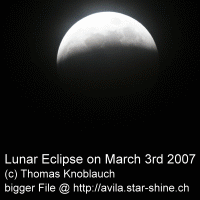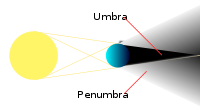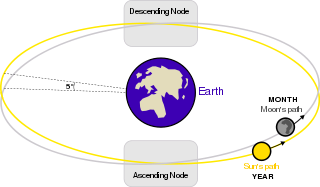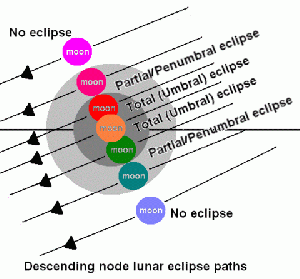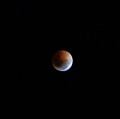Difference between revisions of "Lunar eclipse" - New World Encyclopedia
Rosie Tanabe (talk | contribs) |
|||
| (15 intermediate revisions by 6 users not shown) | |||
| Line 1: | Line 1: | ||
| − | {{ | + | {{Copyedited}}{{Images OK}}{{Submitted}}{{Approved}}{{Paid}} |
[[Image:2007-03-03_-_Lunar_Eclipse_small-43img.gif|right|thumb|Time lapse movie of a lunar eclipse on March 3, 2007.]] | [[Image:2007-03-03_-_Lunar_Eclipse_small-43img.gif|right|thumb|Time lapse movie of a lunar eclipse on March 3, 2007.]] | ||
| − | A '''lunar eclipse''' occurs whenever the [[Moon]] passes through some portion of the [[Earth]]'s shadow. This can occur only when the [[Sun]], Earth, and Moon are aligned exactly, or very closely so, with the Earth in the middle. Hence, the Moon is always [[full moon|full]] during a lunar eclipse. The type and length of an eclipse depend upon the Moon's location relative to its [[lunar node|orbital node]]s. | + | A '''lunar eclipse''' occurs whenever the [[Moon]] passes through some portion of the [[Earth]]'s shadow. This can occur only when the [[Sun]], Earth, and Moon are aligned exactly, or very closely so, with the Earth in the middle. Hence, the Moon is always [[full moon|full]] during a lunar eclipse. The type and length of an eclipse depend upon the Moon's location relative to its [[lunar node|orbital node]]s. Lunar eclipse must have influenced ancient human civilization by challenging people's perception of the universe in the same manner as [[solar eclipse]] has—but probably to a lesser degree. |
| − | + | {{toc}} | |
==Description== | ==Description== | ||
[[Image:Umbra01.svg|right|200px|thumb|Schematic diagram of the shadow cast by a spherical object. Within the central [[umbra]], an object is totally shielded from direct illumination. In contrast, within the [[penumbra]], only a portion of the illumination is blocked.]] | [[Image:Umbra01.svg|right|200px|thumb|Schematic diagram of the shadow cast by a spherical object. Within the central [[umbra]], an object is totally shielded from direct illumination. In contrast, within the [[penumbra]], only a portion of the illumination is blocked.]] | ||
| − | [[Image:Lunar eclipse diagram-en.svg|320px|thumb| | + | [[Image:Lunar eclipse diagram-en.svg|320px|thumb|right|The moon crosses the ecliptic every orbit at positions called nodes. When the full moon occurs in the same position at the node, a lunar eclipse can occur. These two nodes allow two eclipses per year, separated by approximately six months.]] |
| − | A lunar eclipse occurs at least two times a year, whenever some portion of the Earth's shadow falls upon the Moon. The Moon will always be [[full moon|full]] during a lunar eclipse; that is, from the perspective of the Sun, the Moon will be directly behind the Earth. However, since the [[Orbit of the Moon|orbital plane of the Moon]] is inclined by about 5° with respect to the orbital plane of the Earth (the [[ecliptic]]), most full moons occur when the Moon is either north or south of Earth's shadow. Thus in order to be eclipsed, the Moon must be near one of the two intersection points its orbit makes with the ecliptic, which are referred to as the Moon's ascending and descending [[lunar node|node]]s. | + | A lunar eclipse occurs at least two times a year, whenever some portion of the [[Earth]]'s shadow falls upon the [[Moon]]. The Moon will always be [[full moon|full]] during a lunar eclipse; that is, from the perspective of the [[Sun]], the Moon will be directly behind the Earth. However, since the [[Orbit of the Moon|orbital plane of the Moon]] is inclined by about 5° with respect to the orbital plane of the Earth (the [[ecliptic]]), most full moons occur when the Moon is either north or south of Earth's shadow. Thus in order to be eclipsed, the Moon must be near one of the two intersection points its orbit makes with the ecliptic, which are referred to as the Moon's ascending and descending [[lunar node|node]]s. |
The shadow of the Earth can be divided into two distinctive parts: the [[umbra]] and [[penumbra]]. Within the umbra, there is no direct solar radiation. However, as a result of the Sun's large angular size, solar illumination is only partially blocked in the outer portion of the Earth's shadow, which is given the name penumbra. | The shadow of the Earth can be divided into two distinctive parts: the [[umbra]] and [[penumbra]]. Within the umbra, there is no direct solar radiation. However, as a result of the Sun's large angular size, solar illumination is only partially blocked in the outer portion of the Earth's shadow, which is given the name penumbra. | ||
| − | [[Image:Lunareclipsediagram3.gif|left|300px|thumb|Descending node lunar eclipse paths]] | + | [[Image:Lunareclipsediagram3.gif|left|300px|thumb|Descending node lunar eclipse paths.]] |
| − | A | + | A ''penumbral eclipse'' occurs when the Moon passes through the Earth's [[penumbra]]. The penumbra does not cause any noticeable darkening of the Moon's surface, though some may argue it turns a little yellow. A special type of penumbral eclipse is a ''total penumbral eclipse'', during which the Moon lies exclusively within the Earth's penumbra. Total penumbral eclipses are rare, and when these occur, that portion of the Moon which is closest to the umbra can appear somewhat darker than the rest of the Moon. |
| − | A | + | A ''partial lunar eclipse'' occurs when only a portion of the Moon enters the umbra. When the Moon travels completely into the Earth's [[umbra]], one observes a ''total lunar eclipse''. The Moon's speed through the shadow is about one kilometer per second (2300 [[mph]]), and totality may last up to nearly 107 minutes. Nevertheless, the total time between the Moon's first and last contact with the shadow is much longer, and could last up to more than six hours. The relative distance of the Moon from the Earth at the time of an eclipse can affect the eclipse's duration. In particular, when the Moon is near its [[apogee]] (that is, the farthest point from the Earth in its orbit) its orbital speed is the slowest. The diameter of the umbra does not decrease much with distance. Thus, a totally-eclipsed Moon occurring near apogee will lengthen the duration of totality. |
| − | A | + | A ''selenelion'' or ''selenehelion'' is a type of lunar eclipse when, due to the Moon's proximity to the ecliptic, both the Sun and the eclipsed Moon can be observed at the same time. This particular arrangement has led to the phenomenon being referred to as a ''horizontal eclipse''. It can only be observed just prior to sunset or just after sunrise. The specific arrangement is not common, and last occurred on May 16, 2003, over [[Europe]].<ref>{{cite web | url = | title=BBC Weather }}</ref> |
==Appearance== | ==Appearance== | ||
| − | [[Image:Lunareclipses2003.jpg|thumb|250px|right|Lunar eclipses in 2003. Two total lunar eclipses occurred in 2003. The eclipse on May 15 grazed the northern edge of the earth's shadow, and the eclipse on November 8 grazed the southern edge. | + | [[Image:Lunareclipses2003.jpg|thumb|250px|right|Lunar eclipses in 2003. Two total lunar eclipses occurred in 2003. The eclipse on May 15 grazed the northern edge of the earth's shadow, and the eclipse on November 8 grazed the southern edge. These images show the eclipse in November was much brighter as the bottom rim of the Moon did not darken as much after completely entering the umbra. The color and brightness of the Moon during an eclipse varies according to the amount of light refracted by the Earth's atmosphere.]] |
| − | The Moon does not completely disappear as it passes through the umbra because of the [[refraction]] of [[sunlight]] by the Earth's atmosphere into the shadow cone; if the Earth had no atmosphere, the Moon would be completely dark during an eclipse. The red coloring arises because sunlight reaching the Moon must pass through a long and dense layer of the Earth's atmosphere, where it is [[Rayleigh scattering|scattered]]. | + | The Moon does not completely disappear as it passes through the umbra because of the [[refraction]] of [[sunlight]] by the Earth's atmosphere into the shadow cone; if the Earth had no atmosphere, the Moon would be completely dark during an eclipse. The red coloring arises because sunlight reaching the Moon must pass through a long and dense layer of the Earth's atmosphere, where it is [[Rayleigh scattering|scattered]]. Shorter [[wavelength]]s are more likely to be scattered by the small particles, and so by the time the light has passed through the atmosphere, the longer wavelengths dominate. This resulting light we perceive as [[red]]. This is the same effect that causes [[sunset]]s and [[sunrise]]s to turn the sky a reddish color; an alternative way of considering the problem is to realize that, as viewed from the Moon, the Sun would appear to be setting (or rising) behind the Earth. |
| − | The amount of refracted light depends on the amount of dust or clouds in the atmosphere; this also controls how much light is scattered. In general, the dustier the atmosphere, the more that other wavelengths of light will be removed (compared to red light), leaving the resulting light a deeper red color. This causes the resulting coppery-red hue of the Moon to vary from one eclipse to the next. | + | The amount of refracted light depends on the amount of dust or clouds in the atmosphere; this also controls how much light is scattered. In general, the dustier the atmosphere, the more that other wavelengths of light will be removed (compared to red light), leaving the resulting light a deeper red color. This causes the resulting coppery-red hue of the Moon to vary from one eclipse to the next. Volcanoes are notable for expelling large quantities of dust into the atmosphere, and a large eruption shortly before an eclipse can have a large effect on the resulting color (as well as producing many beautiful sunsets around the world). |
| − | The following scale (the [[Danjon scale]]) was devised by [[André Danjon]] for rating the overall darkness of lunar eclipses:<ref>{{cite web | title = Observing and Photographing Lunar Eclipses | url = http://skytonight.com/observing/objects/eclipses/3304036.html | last = Paul Deans and Alan M. MacRobert | publisher = Sky and Telescope}}</ref> | + | The following scale (the [[Danjon scale]]) was devised by [[André Danjon]] for rating the overall darkness of lunar eclipses:<ref>{{cite web | title = Observing and Photographing Lunar Eclipses | url = http://skytonight.com/observing/objects/eclipses/3304036.html | last = Paul Deans and Alan M. MacRobert | publisher = Sky and Telescope | accessdate=December 12, 2007}}</ref> |
:'''L=0''': Very dark eclipse. Moon almost invisible, especially at mid-totality. | :'''L=0''': Very dark eclipse. Moon almost invisible, especially at mid-totality. | ||
:'''L=1''': Dark Eclipse, gray or brownish in colouration. Details distinguishable only with difficulty. | :'''L=1''': Dark Eclipse, gray or brownish in colouration. Details distinguishable only with difficulty. | ||
| Line 34: | Line 34: | ||
:'''L=4''': Very bright copper-red or orange eclipse. Umbral shadow has a bluish, very bright rim. | :'''L=4''': Very bright copper-red or orange eclipse. Umbral shadow has a bluish, very bright rim. | ||
| − | [[Image:LnrEclpse3307.jpg|700px|center|thumb| | + | [[Image:LnrEclpse3307.jpg|700px|center|thumb|Total eclipse on March 3, 2007, as seen from [[Leeds]], [[England]].]] |
==Eclipse cycles== | ==Eclipse cycles== | ||
| − | |||
Every year there are at least two lunar eclipses. If you know the date and time of an eclipse, you can predict the occurrence of other eclipses using [[eclipse cycle]]s, such as the [[Saros cycle]]. Unlike a [[solar eclipse]], which can only be viewed at a certain relatively small area of the world, a lunar eclipse may be viewed from anywhere on the night side of the Earth. | Every year there are at least two lunar eclipses. If you know the date and time of an eclipse, you can predict the occurrence of other eclipses using [[eclipse cycle]]s, such as the [[Saros cycle]]. Unlike a [[solar eclipse]], which can only be viewed at a certain relatively small area of the world, a lunar eclipse may be viewed from anywhere on the night side of the Earth. | ||
| Line 43: | Line 42: | ||
==See also== | ==See also== | ||
| + | * [[Solar eclipse]] | ||
| + | * [[Moon]] | ||
* [[Earth]] | * [[Earth]] | ||
| − | * [[ | + | * [[Sun]] |
* [[Natural satellite]] | * [[Natural satellite]] | ||
| − | |||
* [[Solar System]] | * [[Solar System]] | ||
| − | |||
== Gallery == | == Gallery == | ||
| − | + | <gallery> | |
Image:Lunar2007 eclipse-LiamG.jpg|March 2007. The advancing shadow of Earth brings out detail on the lunar surface. The huge ray system emanating from [[Tycho (crater)|Tycho]] is shown as the dominant feature on the southern hemisphere. | Image:Lunar2007 eclipse-LiamG.jpg|March 2007. The advancing shadow of Earth brings out detail on the lunar surface. The huge ray system emanating from [[Tycho (crater)|Tycho]] is shown as the dominant feature on the southern hemisphere. | ||
Image:Lunar eclipse with stars.JPG|August 2007. A total lunar eclipse allows more [[star]]s to be seen near the Moon. | Image:Lunar eclipse with stars.JPG|August 2007. A total lunar eclipse allows more [[star]]s to be seen near the Moon. | ||
Image:Total lunar eclipse and milky way.jpg|August 2007. A total lunar eclipse and [[Milky Way]]. | Image:Total lunar eclipse and milky way.jpg|August 2007. A total lunar eclipse and [[Milky Way]]. | ||
Image:August_2007_Lunar_Eclipse.jpg|August 28, 2007 lunar eclipse, a collage of photos taken from the Oregon coast by Randall Scholten. | Image:August_2007_Lunar_Eclipse.jpg|August 28, 2007 lunar eclipse, a collage of photos taken from the Oregon coast by Randall Scholten. | ||
| − | Image:2007-08-28 Melbourne lunar eclipse Dsc 2519.jpg|Total lunar eclipse taken from Melbourne, Australia on August 28, 2007 | + | Image:2007-08-28 Melbourne lunar eclipse Dsc 2519.jpg|Total lunar eclipse taken from Melbourne, Australia on August 28, 2007. |
| − | Image:Total lunar eclipse august 28 2007 edit.jpg|A sequence of images taken at | + | Image:Total lunar eclipse august 28 2007 edit.jpg|A sequence of images taken at three minute intervals showing the [[28 August 2007 lunar eclipse]]. |
Image:Lunar-eclipse-2004.jpg|Multiple exposure composite photo of the lunar eclipse of October 2004 as seen from Northern California. | Image:Lunar-eclipse-2004.jpg|Multiple exposure composite photo of the lunar eclipse of October 2004 as seen from Northern California. | ||
| − | </gallery | + | </gallery> |
== Notes == | == Notes == | ||
| Line 65: | Line 64: | ||
==References == | ==References == | ||
| − | + | ||
| + | * Lunar Eclipse Resources. http://xjubier.free.fr/en/site_pages/Lunar_Eclipses.html. Retrieved December 12, 2007. | ||
| + | * Lunar Eclipses for Beginners. http://www.mreclipse.com/Special/LEprimer.html. Retrieved December 12, 2007. | ||
| + | * NASA Lunar Eclipse Page. http://sunearth.gsfc.nasa.gov/eclipse/lunar.html. Retrieved December 12, 2007. | ||
== External links == | == External links == | ||
| − | + | All links retrieved November 4, 2022. | |
| − | + | * [http://www.shadowandsubstance.com/ Shadow and Substance for animation of future and past eclipses] | |
| − | + | * [http://www.space.com/15689-lunar-eclipses.html Lunar Eclipses: What Are They; When is the Next One?] | |
| − | |||
| − | |||
| − | * [http://www.shadowandsubstance.com/ Shadow and Substance for animation of future and past eclipses] | ||
| − | * [http://www. | ||
[[Category:Physical sciences]] | [[Category:Physical sciences]] | ||
Latest revision as of 10:38, 9 March 2023
A lunar eclipse occurs whenever the Moon passes through some portion of the Earth's shadow. This can occur only when the Sun, Earth, and Moon are aligned exactly, or very closely so, with the Earth in the middle. Hence, the Moon is always full during a lunar eclipse. The type and length of an eclipse depend upon the Moon's location relative to its orbital nodes. Lunar eclipse must have influenced ancient human civilization by challenging people's perception of the universe in the same manner as solar eclipse has—but probably to a lesser degree.
Description
A lunar eclipse occurs at least two times a year, whenever some portion of the Earth's shadow falls upon the Moon. The Moon will always be full during a lunar eclipse; that is, from the perspective of the Sun, the Moon will be directly behind the Earth. However, since the orbital plane of the Moon is inclined by about 5° with respect to the orbital plane of the Earth (the ecliptic), most full moons occur when the Moon is either north or south of Earth's shadow. Thus in order to be eclipsed, the Moon must be near one of the two intersection points its orbit makes with the ecliptic, which are referred to as the Moon's ascending and descending nodes.
The shadow of the Earth can be divided into two distinctive parts: the umbra and penumbra. Within the umbra, there is no direct solar radiation. However, as a result of the Sun's large angular size, solar illumination is only partially blocked in the outer portion of the Earth's shadow, which is given the name penumbra.
A penumbral eclipse occurs when the Moon passes through the Earth's penumbra. The penumbra does not cause any noticeable darkening of the Moon's surface, though some may argue it turns a little yellow. A special type of penumbral eclipse is a total penumbral eclipse, during which the Moon lies exclusively within the Earth's penumbra. Total penumbral eclipses are rare, and when these occur, that portion of the Moon which is closest to the umbra can appear somewhat darker than the rest of the Moon.
A partial lunar eclipse occurs when only a portion of the Moon enters the umbra. When the Moon travels completely into the Earth's umbra, one observes a total lunar eclipse. The Moon's speed through the shadow is about one kilometer per second (2300 mph), and totality may last up to nearly 107 minutes. Nevertheless, the total time between the Moon's first and last contact with the shadow is much longer, and could last up to more than six hours. The relative distance of the Moon from the Earth at the time of an eclipse can affect the eclipse's duration. In particular, when the Moon is near its apogee (that is, the farthest point from the Earth in its orbit) its orbital speed is the slowest. The diameter of the umbra does not decrease much with distance. Thus, a totally-eclipsed Moon occurring near apogee will lengthen the duration of totality.
A selenelion or selenehelion is a type of lunar eclipse when, due to the Moon's proximity to the ecliptic, both the Sun and the eclipsed Moon can be observed at the same time. This particular arrangement has led to the phenomenon being referred to as a horizontal eclipse. It can only be observed just prior to sunset or just after sunrise. The specific arrangement is not common, and last occurred on May 16, 2003, over Europe.[1]
Appearance

The Moon does not completely disappear as it passes through the umbra because of the refraction of sunlight by the Earth's atmosphere into the shadow cone; if the Earth had no atmosphere, the Moon would be completely dark during an eclipse. The red coloring arises because sunlight reaching the Moon must pass through a long and dense layer of the Earth's atmosphere, where it is scattered. Shorter wavelengths are more likely to be scattered by the small particles, and so by the time the light has passed through the atmosphere, the longer wavelengths dominate. This resulting light we perceive as red. This is the same effect that causes sunsets and sunrises to turn the sky a reddish color; an alternative way of considering the problem is to realize that, as viewed from the Moon, the Sun would appear to be setting (or rising) behind the Earth.
The amount of refracted light depends on the amount of dust or clouds in the atmosphere; this also controls how much light is scattered. In general, the dustier the atmosphere, the more that other wavelengths of light will be removed (compared to red light), leaving the resulting light a deeper red color. This causes the resulting coppery-red hue of the Moon to vary from one eclipse to the next. Volcanoes are notable for expelling large quantities of dust into the atmosphere, and a large eruption shortly before an eclipse can have a large effect on the resulting color (as well as producing many beautiful sunsets around the world).
The following scale (the Danjon scale) was devised by André Danjon for rating the overall darkness of lunar eclipses:[2]
- L=0: Very dark eclipse. Moon almost invisible, especially at mid-totality.
- L=1: Dark Eclipse, gray or brownish in colouration. Details distinguishable only with difficulty.
- L=2: Deep red or rust-colored eclipse. Very dark central shadow, while outer edge of umbra is relatively bright.
- L=3: Brick-red eclipse. Umbral shadow usually has a bright or yellow rim.
- L=4: Very bright copper-red or orange eclipse. Umbral shadow has a bluish, very bright rim.

Eclipse cycles
Every year there are at least two lunar eclipses. If you know the date and time of an eclipse, you can predict the occurrence of other eclipses using eclipse cycles, such as the Saros cycle. Unlike a solar eclipse, which can only be viewed at a certain relatively small area of the world, a lunar eclipse may be viewed from anywhere on the night side of the Earth.
See also
Gallery
August 2007. A total lunar eclipse allows more stars to be seen near the Moon.
Notes
- ↑ Error on call to template:cite web: Parameters url and title must be specified.
- ↑ Paul Deans and Alan M. MacRobert. Observing and Photographing Lunar Eclipses. Sky and Telescope. Retrieved December 12, 2007.
ReferencesISBN links support NWE through referral fees
- Lunar Eclipse Resources. http://xjubier.free.fr/en/site_pages/Lunar_Eclipses.html. Retrieved December 12, 2007.
- Lunar Eclipses for Beginners. http://www.mreclipse.com/Special/LEprimer.html. Retrieved December 12, 2007.
- NASA Lunar Eclipse Page. http://sunearth.gsfc.nasa.gov/eclipse/lunar.html. Retrieved December 12, 2007.
External links
All links retrieved November 4, 2022.
- Shadow and Substance for animation of future and past eclipses
- Lunar Eclipses: What Are They; When is the Next One?
Credits
New World Encyclopedia writers and editors rewrote and completed the Wikipedia article in accordance with New World Encyclopedia standards. This article abides by terms of the Creative Commons CC-by-sa 3.0 License (CC-by-sa), which may be used and disseminated with proper attribution. Credit is due under the terms of this license that can reference both the New World Encyclopedia contributors and the selfless volunteer contributors of the Wikimedia Foundation. To cite this article click here for a list of acceptable citing formats.The history of earlier contributions by wikipedians is accessible to researchers here:
The history of this article since it was imported to New World Encyclopedia:
Note: Some restrictions may apply to use of individual images which are separately licensed.
